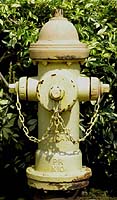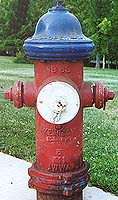
|

|

|

|
|
1385 Nozzles: 1x 4" Size: 4" V.O. Dated: 1955, (rear view) Location: Jack S. collection Photo: © 2001, J. Anderson |
1386 Nozzles: 1x 4" Size: 4" V.O. Dated: 1959, (rear view) Location: Jack S. collection Photo: © 2001, J. Anderson |
1384 Nozzles: 1x 2½", 1x 4" Size: 4" V.O. Dated: 1954, (rear view) Location: Jack S. collection Photo: © 2001, J. Anderson |
2026 Nozzles: 2x 2½", 1x 5" Size: ? V.O. Dated: ? Location: Private collection Photo: © 2003, Kent Wheeler |

|

|
||
|
1113 Nozzles: 2x 2½" Size: 5" V.O., 9 5/8" barrel O.D. Dated: 1952 Location: Ed M. collection Photo: © 2001, Ed Masminster |
1114 Nozzles: 2x 2½", 1x 4" Size: 5" V.O., 9 5/8" barrel O.D. Dated: 1953 Location: Ed M. collection Photo: © 2001, Ed Masminster |
|
|
These two models are externally identical above the joint of the 2 piece barrels.
|
|
|
The K10 and K12 models are externally identical except for the model designation cast onto the barrel.
|

|

|

|

|
|
1257 Nozzles: 2x 2½" Dated: 1964 Note: "K10" on back Location: John A. collection Photo: © 2001, John Anderson |
0015 Nozzles: 2x 2½" Dated: 1965 Note: "K10" on front Location: Prairie du Chien,WI Photo: © 2000, Jim Quist |
1256 Nozzles: 2x 2½", 1x 4½" Dated: 1974 Note: "K10" on front Location: John A. collection Photo: © 2001, John Anderson |
2142 Nozzles: 2x 2½", 1x 4½" Dated: 1976 Note: "K10B" in front Location: John A. collection Photo: © 2004, John Anderson |

|
|||
|
2532 Puerto Rico spec Nozzles: 2x 2½", 1x 4½" Dated: 2005 Note: "PR/K10" in front Location: Dorado, PR Photo: © 2010, J. Anderson |
|
|
This model has the same large threaded coupler holding the upper and lower barrels together as
the Figure 1280 model.
This first group is early production hydrants with the K11 model designation on the back of the barrel and 1,883,467 and 1,944,777 patent numbers cast onto the threaded coupler. |

|

|
||
|
1255 Nozzles: 2x 2½" Dated: 1961 Note: "K11" on back Location: John A. collection Photo: © 2001, John Anderson |
1254 Nozzles: 2x 2½", 1x 4½" Dated: 1959 Note: "K11" on back Location: John A. collection Photo: © 2001, Ed Masminster |
|
This second group is later production hydrants with the K11 model designation on the front of the barrel and no patent numbers on the threaded coupler. |

|

|

|

|
|
1253 Nozzles: 1x 4" Dated: 1979 Note: "K11" on front Location: John A. collection Photo: © 2001, John Anderson |
1115 Nozzles: 2x 2½" Dated: 1967 Note: "K11" on front Location: Ed M. collection Photo: © 2001, Ed Masminster |
0185 Nozzles: 2x 2½", 1x 4½" Dated: 1969 Note: "K11" on front Location: John A. collection Photo: © 2001, John Anderson |
0017 Nozzles: 2x 2½", 1x ~5" Dated: 1968 Note: "K11" on front Location: Private collection Photo: © 2006, Larry Longest |
|
|
This hydrant is basically a K10 hydrant with a bronze top stem and UA/FM (or UL/FM) markings.
This first group is marked UA-FM; where the UA stands for Underwriter's Association. |

|

|

|

|
|
1252 Nozzles: 2x 2½" Dated: 1959 Note: "K12" between nozzles Location: John A. collection Photo: © 2001, John Anderson |
1116 Nozzles: 2x 2½" Dated: 1967 Note: "K12" under nozzle Location: Ed M. collection Photo: © 2001, Ed Masminster |
0083 Nozzles: 2x 2½" externally gated Dated: 1969 Location: Roanoke, VA Photo: © Ethan Kennedy |
1926 Nozzles: 2x 2½", 1x 4½" Dated: 1970 Note: "K12" in front Location: John A. collection Photo: © 2003, John Anderson |
| This second group is marked UL-FM; where the UL stands for the renamed Underwriter's Laboratories. |

|

|
||
|
2088 Nozzles: 2x 2½" Dated: 1984 Note: "K12" under nozzle Location: Jason C. collection Photo: © 2004, J. Cherry |
2143 Nozzles: 2x 2½", 1x 4½" Dated: 1984 Note: "K12" in front Location: John A. collection Photo: © 2004, John Anderson |
|
Part 1 | Part 2a , 2b | Part 3 Unless otherwise noted, all contents of these WWW pages © 1996-01, FireHydrant.org |